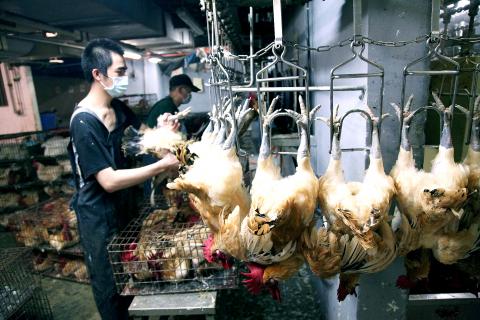|
Five Chinese
provinces on travel alert
BIRD FLU PRECAUTIONS: The Level-2 travel
advisory also includes Shanghai and Beijing, while the COA said it would move
its live slaughter ban forward one month
By Mo Yan-chih / Staff reporter, with CNA

A worker hangs dead chickens onto
hooks in the chicken slaughterhouse at Huannan Market in Taipei yesterday, one
day after the nation reported its first case of the H7N9 avian influenza
infection.
PHOTO: DAVID CHANG, EPA
Taiwan yesterday issued a Level-2 travel
advisory for five Chinese provinces and two metropolitan areas after confirming
a day earlier the first H7N9 avian influenza case reported locally, but
contracted in China.
The Central Epidemic Command Center announced the listing of the five Chinese
provinces — Jiangsu, Henan, Zhejiang, Anhui and Shandong — and two cities —
Shanghai and Beijing — in its Level-2 travel alert after an inter-ministerial
meeting.
“We referred to the three-level travel advisory system used by the US Centers
for Disease Control and Prevention when deciding to issue a Level-2 advisory for
the seven destinations,” said Centers for Disease Control Director-General Chang
Feng-yee (張烽義), head of the epidemic command center.
Under the system, a Level-1 advisory urges those who are bound for listed
destinations to exercise vigilance and take health precautions, while a Level-2
alert calls for would-be travelers to maintain a high degree of caution and take
strengthened protective measures, especially when they visit certain high-risk
places.
A Level-3 travel advisory warns against travel to listed destinations.
“Because all seven of the listed destinations have reported confirmed H7N9
cases, people planning to travel there should pay close attention to their
personal health and hygiene,” Chang said.
Tourists visiting these areas are advised to take extra precautions, and risks
to travelers are higher in certain locations within those areas, the center
added.
In light of the nation’s first confirmed H7N9 case, reported on Wednesday, the
Council of Agriculture (COA) yesterday also announced it would move forward the
date banning traditional markets from live poultry slaughter by one month, from
its original date of June 17.
Starting in May 17, all traditional markets with the exception of outlying
islands and rural areas will be barred from slaughtering livestock on site in
markets, the council said.
Meanwhile, Taipei Mayor Hau Lung-bin (郝龍斌) dismissed speculation that Taipei
will launch the ban today, as some local media outlets quoted COA Minister Chen
Bao-ji (陳保基) as saying earlier yesterday.
“What we will do starting on Friday is to enhance communication with vendors
that still offer live poultry slaughtering at traditional markets and encourage
them to sell frozen meat instead,” he said.
Taipei Deputy Mayor Chen -Hsiung-wen (陳雄文), who also serves as the director of
Taipei’s H7N9 emergency response center, said the city government would meet
with directors of traditional market associations and 177 vendors that continued
to sell live poultry to explain the ban.
To smooth the implementation of the ban, the city government will give a
NT$100,000 subsidy to poultry vendors that become frozen poultry suppliers.
Those who decide to quit the business altogether will receive a subsidy of
NT$600,000 for returning their vending booths to city markets.
Chen said vendors who insisted on selling live poultry after May 17 will be
fined for violating the Animal Industry Act (畜牧法).
According to Taipei City’s Market Administration Office, between 50,000 and
60,000 birds are slaughtered in the city a day, with between 20,000 and 30,000
slaughtered at Huanan Public Market in Wanhua District (萬華).
Chen said that the city would start sending all live poultry to the public
market, which has 14 slaughtering lines, to handle the poultry slaughter.
He added that the emergency response center would hold a cross-departmental
meeting regularly to monitor the situation.
Additional reporting by staff writer
|
![]()
![]()
![]()